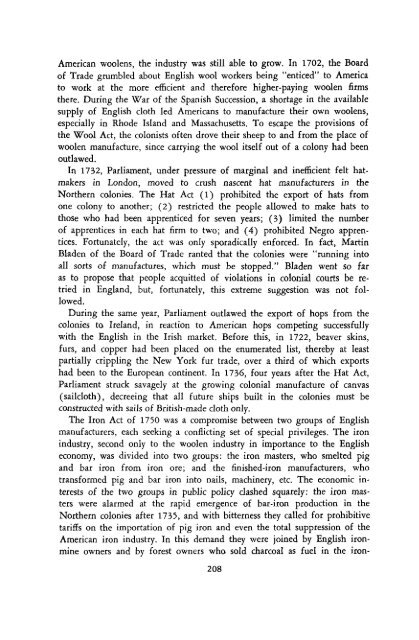Conceived in Liberty Volume 2 - Ludwig von Mises Institute
Conceived in Liberty Volume 2 - Ludwig von Mises Institute
Conceived in Liberty Volume 2 - Ludwig von Mises Institute
Create successful ePaper yourself
Turn your PDF publications into a flip-book with our unique Google optimized e-Paper software.
American woolens, the <strong>in</strong>dustry was still able to grow. In 1702, the Board<br />
of Trade grumbled about English wool workers be<strong>in</strong>g "enticed" to America<br />
to work at the more efficient and therefore higher-pay<strong>in</strong>g woolen firms<br />
there. Dur<strong>in</strong>g the War of the Spanish Succession, a shortage <strong>in</strong> the available<br />
supply of English cloth led Americans to manufacture their own woolens,<br />
especially <strong>in</strong> Rhode Island and Massachusetts. To escape the provisions of<br />
the Wool Act, the colonists often drove their sheep to and from the place of<br />
woolen manufacture, s<strong>in</strong>ce carry<strong>in</strong>g the wool itself out of a colony had been<br />
outlawed.<br />
In 1732, Parliament, under pressure of marg<strong>in</strong>al and <strong>in</strong>efficient felt hatmakers<br />
<strong>in</strong> London, moved to crush nascent hat manufacturers <strong>in</strong> the<br />
Northern colonies. The Hat Act (1) prohibited the export of hats from<br />
one colony to another; (2) restricted the people allowed to make hats to<br />
those who had been apprenticed for seven years; (3) limited the number<br />
of apprentices <strong>in</strong> each hat firm to two; and (4) prohibited Negro apprentices.<br />
Fortunately, the act was only sporadically enforced. In fact, Mart<strong>in</strong><br />
Bladen of the Board of Trade ranted that the colonies were "runn<strong>in</strong>g <strong>in</strong>to<br />
all sorts of manufactures, which must be stopped." Bladen went so far<br />
as to propose that people acquitted of violations <strong>in</strong> colonial courts be retried<br />
<strong>in</strong> England, but, fortunately, this extreme suggestion was not followed.<br />
Dur<strong>in</strong>g the same year, Parliament outlawed the export of hops from the<br />
colonies to Ireland, <strong>in</strong> reaction to American hops compet<strong>in</strong>g successfully<br />
with the English <strong>in</strong> the Irish market. Before this, <strong>in</strong> 1722, beaver sk<strong>in</strong>s,<br />
furs, and copper had been placed on the enumerated list, thereby at least<br />
partially crippl<strong>in</strong>g the New York fur trade, over a third of which exports<br />
had been to the European cont<strong>in</strong>ent. In 1736, four years after the Hat Act,<br />
Parliament struck savagely at the grow<strong>in</strong>g colonial manufacture of canvas<br />
(sailcloth), decree<strong>in</strong>g that all future ships built <strong>in</strong> the colonies must be<br />
constructed with sails of British-made cloth only.<br />
The Iron Act of 1750 was a compromise between two groups of English<br />
manufacturers, each seek<strong>in</strong>g a conflict<strong>in</strong>g set of special privileges. The iron<br />
<strong>in</strong>dustry, second only to the woolen <strong>in</strong>dustry <strong>in</strong> importance to the English<br />
economy, was divided <strong>in</strong>to two groups: the iron masters, who smelted pig<br />
and bar iron from iron ore; and the f<strong>in</strong>ished-iron manufacturers, who<br />
transformed pig and bar iron <strong>in</strong>to nails, mach<strong>in</strong>ery, etc. The economic <strong>in</strong>terests<br />
of the two groups <strong>in</strong> public policy clashed squarely: the iron masters<br />
were alarmed at the rapid emergence of bar-iron production <strong>in</strong> the<br />
Northern colonies after 1735, and with bitterness they called for prohibitive<br />
tariffs on the importation of pig iron and even the total suppression of the<br />
American iron <strong>in</strong>dustry. In this demand they were jo<strong>in</strong>ed by English ironm<strong>in</strong>e<br />
owners and by forest owners who sold charcoal as fuel <strong>in</strong> the iron-<br />
208
















